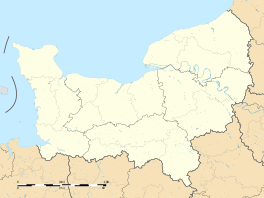Colleville-Montgomery
| Colleville-Montgomery | ||
|---|---|---|
 |
||
|
||
| Coordinates: 49°17′00″N 0°18′00″W / 49.2833°N 0.3000°WCoordinates: 49°17′00″N 0°18′00″W / 49.2833°N 0.3000°W | ||
| Country | France | |
| Region | Normandy | |
| Department | Calvados | |
| Arrondissement | Caen | |
| Canton | Ouistreham | |
| Government | ||
| • Mayor (2008–2014) | Guy Legrand | |
| Area1 | 7.74 km2 (2.99 sq mi) | |
| Population (2008)2 | 2,191 | |
| • Density | 280/km2 (730/sq mi) | |
| Time zone | CET (UTC+1) | |
| • Summer (DST) | CEST (UTC+2) | |
| INSEE/Postal code | 14166 /14880 | |
| Elevation | 3–58 m (9.8–190.3 ft) (avg. 10 m or 33 ft) |
|
|
1 French Land Register data, which excludes lakes, ponds, glaciers > 1 km² (0.386 sq mi or 247 acres) and river estuaries. 2Population without double counting: residents of multiple communes (e.g., students and military personnel) only counted once. |
||
1 French Land Register data, which excludes lakes, ponds, glaciers > 1 km² (0.386 sq mi or 247 acres) and river estuaries.
Colleville-Montgomery (Colleville-sur-Orne) is a commune in the Calvados department in the Normandy region in northern France. It was known as Colleville-sur-Orne until June 13, 1946, to distinguish it from another town in the department, also in a coastal location, Colleville-sur-Mer. The new name honoured the British commander Sir Bernard Montgomery who commanded the invasion of Normandy on June 6, 1944. There are two towns, Calvados Sainte-Foy-de-Montgomery and Saint-Germain-de- Montgomery in the area, but they are named for Montgomery's family ancestors. They were part of William the Conqueror's invading army in 1066 and settled in England.
Built by Saint-Vigor, Bishop of the city of Bayeux (511-531), during the 11th and 12th centuries, it has two choirs and a Romanesque nave.
The first bay consists in barrel vaults. The other vaults are more recent, built at the same time as the arches which lead to the second choir, from the eighteenth century.
The side tower from the twelfth century is of Romanesque design, with a terrace on top surrounded by a parapet, and contains three bells. The bell tower, partially destroyed during the liberation of the area, was reconstructed.
The windows were designed in the style of Gothic architecture and their stained glass were restored after World War II.
Built by the German army in 1942, it consists of a complex of bunkers which are being restored since 1990 by an association called "Les Amis du Suffolk Régiment". Free guided visits are organised during the summer.
...
Wikipedia



